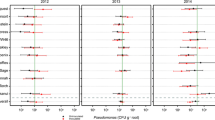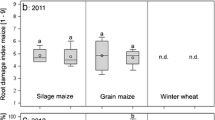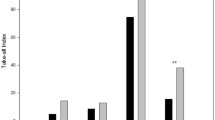Abstract
In a study, over three growing seasons, of Gaeumannomyces graminis var. tritici (Ggt) and take-all disease in commercial wheat fields (that were in their first, second, third or fourth year of consecutive wheat) in New Zealand, Ggt concentrations in soil (the amount of Ggt DNA measured using quantitative PCR) and take-all incidence and take-all index (TAI) were least at the start of a wheat sequence and stabilized in third and fourth consecutive wheat crops. Median Ggt concentrations in soil increased 10-fold during a first wheat crop, reaching 78 pg Ggt DNA/g soil after harvest. Growing season rainfall and position in a continuous wheat crop sequence were most closely associated with TAI and post-harvest soil Ggt concentrations, but other factors were also associated with inoculum and disease. Inoculum concentrations, disease incidence and TAI were greater where the frequency of crops susceptible to Ggt (wheat, barley or triticale) was greatest in the crop rotations and where crops were irrigated. Irrigation in particular was associated with high post-harvest soil Ggt concentrations in the driest of the three growing seasons assessed, when environmental conditions were least favourable for disease development. There was evidence of take-all decline following two wheat crops where environmental conditions had enabled severe epidemics to occur. Our study showed that frequency of cereal crops in the rotation, length of breaks between host crops, irrigation and growing season rainfall interact over the course of a cropping sequence to influence TAI when wheat is sown.





Similar content being viewed by others
References
Bailey DJ, Gilligan CA (1999) Dynamics of primary and secondary infection in take-all epidemics. Phytopathology 89:84–91
Bailey DJ, Paveley N, Spink J, Lucas P, Gilligan CA (2009) Epidemiological analysis of take-all decline in winter wheat. Phytopathology 99:861–868
Bateman GL, Hornby D (1999) Comparison of natural and artificial epidemics of take-all in sequences of winter wheat crops. Ann Appl Biol 135:555–571
Bateman GL, Gutteridge RJ, Jenkyn JF (2004) Take-all and grain yields in sequences of winter wheat crops testing fluquinconazole seed treatment applied in different combinations of years. Ann Appl Biol 145:317–330
Bateman GL, Gutteridge RJ, Jenkyn JF, Self MM (2008) Effects of fluquinconazole and silthiofam, applied as seed treatments to single or consecutive crops of wheat, on take-all epidemic development and grain yields. Ann Appl Biol 152:243–254
Bithell SL, McLachlan ARG, Hide CCL, McKay A, Cromey MG (2009) Changes in post-harvest levels of Gaeumannomyces graminis var. tritici inoculum in wheat fields. Australas Plant Pathol 38:277–283
Bithell SL, McKay A, Butler RC, Herdina O-KK, Hartley D, Cromey MG (2012a) Predicting take-all severity in second-year wheat using soil DNA concentrations of Gaeumannomyces graminis var. tritici determined with qPCR. Plant Dis 96:443–451
Bithell SL, McKay A, Cromey MG (2012b) Low frequency of Gaeumannomyces graminis var. avenae in New Zealand: implications for take-all management in wheat. Australas Plant Pathol 41:173–178
Cook RJ (2003) Take-all of wheat. Physiol Mol Plant Pathol 62:73–86
Cotterill PJ, Sivasithamparam K (1988) Inoculum of the take-all fungus in rotations of wheat and pasture: relationships to disease and yield of wheat. Trans Br Mycol Soc 91:63–72
Cromey MG, Parkes RA, Fraser PM (2006) Factors associated with stem base and root diseases of New Zealand wheat and barley crops. Australas Plant Pathol 35:1–10
Gutteridge RJ, Hornby D (2003) Effects of sowing date and volunteers on the infectivity of soil infested with Gaeumannomyces graminis var. tritici and on take-all disease in successive crops of winter wheat. Ann Appl Biol 143:275–282
Haling E et al (2011) Direct measurement of roots in soil for single and mixed species using a quantitative DNA-based method. Plant Soil 348:123–127
Hardwick NV, Jones DR, Slough JE (2001) Factors affecting diseases of winter wheat in England and Wales, 1989–98. Plant Pathol 50:453–462
Heritage AD, Rovira AD, Bowen GD, Correll RL (1989) Influence of soil water on the growth of Gaeumannomyces graminis var. tritici in soil: use of a mathematical model. Soil Biol Biochem 21:729–732
Hornby D (1975) Inoculum of the take-all fungus: nature, measurement, distribution and survival. EPPO Bull 5:319–333
Hornby D (1978) The problems of trying to forecast take-all. In: Scott PR, Bainbridge A (eds) Plant disease epidemiology. Blackwell Scientific Publications, Oxford, pp 151–158
Hornby D (1981) Inoculum. In: Asher MJC, Shipton PJ (eds) Biology and control of take-all. Academic Press Inc. (London) Ltd, London, pp 271–293
Hornby D (1998) Take-all disease of cereals: a regional perspective. Cab International, Wallingford
Hornby D, Beale R (2000) Take-all management guide. Monsanto Plc, Agricultural Sector, Maris Lane, Trumpington, Cambridge
Jamieson PD, Porter JR, Wilson DR (1991) A test of the computer simulation model ARCWHEAT1 on wheat crops grown in New Zealand. Field Crops Res 27:337–350
Jamieson PD, Martin RJ, Francis GS (1995) Drought influences on grain-yield of barley, wheat, and maize. N Z J Crop Hortic Sci 23:55–66
Lebreton L, Gosme M, Lucas P, Guillerm-Erckelboudt AY, Sarniguet A (2007) Linear relationship between Gaeumannomyces graminis var. tritici (Ggt) genotypic frequencies and disease severity on wheat roots in the field. Environ Microbiol 9:492–499
MacNish GC (1973) Survival of Gaeumannomyces graminis var. tritici in field soil stored in controlled environments. Aust J Biol Sci 26:1319–1325
MacNish GC, Dodman RL (1973) Survival of Gaeumannomyces graminis var. tritici in the field. Aust J Biol Sci 26:1309–1317
McEwen J, Darby RJ, Hewitt MV, Yeoman DP (1989) Effects of field beans, fallow, lupins, oats, oilseed rape, peas, ryegrass, sunflowers and wheat on nitrogen residues in the soil and on the growth of a subsequent wheat crop. J Agric Sci 115:209–219
Murray GM, Heenan DP, Taylor AC (1991) The effect of rainfall and crop management on take-all and eyespot of wheat in the field. Aust J Exp Agric 31:645–651
Nilsson HE, Smith JD (1981) Take-all of grasses. In: Asher MJC, Shipton PJ (eds) Biology and control of take-all. Academic Press Inc, London, pp 433–448
Ophel-Keller K, McKay A, Hartley D, Herdina CJ (2008) Development of a routine DNA-based testing service for soilborne diseases in Australia. Australas Plant Pathol 37:243–253
Paulitz TC, Schroeder KL, Schillinger WF (2010) Soilborne pathogens of cereals in an irrigated cropping system: effects of tillage, residue management, and crop rotation. Plant Dis 94:61–66
Pillinger C, Paveley N, Foulkes J, Spink J (2005) Explaining variation in the effects of take-all (Gaeumannomyces graminis var. tritici) on nitrogen and water uptake in wheat. Plant Pathol 54:491–501
Polley RW, Thomas MR (1991) Surveys of diseases of winter wheat in England and Wales, 1976–1988. Ann Appl Biol 119:1–20
Prew RD (1980) Studies on the spread of Gaeumannomyces graminis var. tritici in wheat. II. The effect of cultivations. Ann Appl Biol 94:397–404
Smiley RW (2009) Water and temperature parameters associated with winter wheat diseases caused by soilborne pathogens. Plant Dis 93:73–80
van den Berg F, Gilligan CA, Bailey DJ, van den Bosch F (2010) Periodicity in host availability does not account for evolutionary branching as observed in many plant pathogens: an application to Gaeumannomyces graminis var. tritici. Phytopathology 100:1169–1175
Yarham DJ (1981) Practical aspects of epidemiology and control. In: Asher MJC, Shipton PJ (eds) Biology and control of take-all. Academic Press Inc. (London) Ltd, London, pp 353–384
Acknowledgments
We thank the farmers who gave access to their fields and field management information for this study. We also thank Ina Dumitrescu, Russell Burns and Aidan Thomson for processing the samples. The research was funded by a Ministry of Science and Innovation contract (LINX0804) and the MAF Sustainable Farming Fund.
Author information
Authors and Affiliations
Corresponding author
Rights and permissions
About this article
Cite this article
Bithell, S.L., Butler, R.C.C., McKay, A.C. et al. Influences of crop sequence, rainfall and irrigation, on relationships between Gaeumannomyces graminis var. tritici and take-all in New Zealand wheat fields. Australasian Plant Pathol. 42, 205–217 (2013). https://doi.org/10.1007/s13313-012-0168-9
Received:
Accepted:
Published:
Issue Date:
DOI: https://doi.org/10.1007/s13313-012-0168-9




